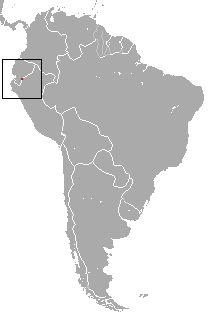Andean caenolestid facts for kids
Quick facts for kids Andean caenolestid |
|
|---|---|
| Conservation status | |
| Scientific classification | |
| Genus: |
Caenolestes
|
| Species: |
condorensis
|
 |
|
| Range of C. condorensis | |
The Andean caenolestid (Caenolestes condorensis) is a small animal that looks a bit like a shrew. It is also known as the Andean shrew opossum or Condor caenolestid. This animal is only found in a place called Cordillera del Cóndor in Ecuador. This is where it was first discovered.
Two zoologists, Bruce D. Patterson and Albuja V. Luis, first described this species in 1996. The Andean caenolestid is the largest of all caenolestids. The IUCN (International Union for Conservation of Nature) says it is a vulnerable species. This means its population is at risk. In 2015, scientists thought there were fewer than 1,000 of these animals left.
About its Name and Family
The Andean caenolestid is one of five types of animals in the group Caenolestes. These animals belong to the family Caenolestidae, which are often called shrew opossums.
Scientists Bruce D. Patterson and Albuja V. Luis first described this animal in 1996. They studied an adult male animal found in Cordillera del Cóndor in Ecuador. They found a total of three of these animals.
For a while, scientists thought Caenolestes was closely related to another group called Lestoros (the Incan caenolestid). But over time, they saw that Lestoros looked different. Later studies, which looked at their bodies and mitochondrial DNA, showed how they are related. The Incan caenolestid and the long-nosed caenolestid are actually close relatives to the Caenolestes group.
Fossils of caenolestids show they have been around for a very long time. They date back to the early Eocene epoch, which was almost 55 million years ago.
The name Caenolestes comes from ancient Greek words. Kainos means "new," and lestes means "robber" or "pirate." The species name condorensis comes from the place where it was found, Cordillera del Cóndor. This is why it is also called the 'Condor caenolestid'.
What it Looks Like
Patterson and Luis found that the Andean caenolestid is the biggest animal in its family. It has large, strong canine teeth. Its snout is long, about 2 centimeters (0.8 inches) long. It also has a big skull, almost 3.8 centimeters (1.5 inches) long.
This animal has whitish whiskers and a dark brown fur coat. It also has a dark spot on its chest. Scientists measured the animals they found. Their total length was about 26 centimeters (10 inches). They weighed about 48 grams (1.7 ounces). Their tails were about 13 centimeters (5 inches) long. Their back feet were 3 centimeters (1.2 inches) long, and their ears were 1.8 centimeters (0.7 inches) long.
Males are generally bigger than females. This difference between male and female sizes is called Sexual dimorphism.
Where it Lives and its Status
The Andean caenolestid is only known from the Cordillera del Cóndor. This area is in the eastern part of the Andes mountains. The land there has old ash from the Cretaceous period. The plants are usually less than 1.5 meters (5 feet) tall. You can also find bromeliads there, which are plants locally known as "achupallas."
The animals were found where two different types of land meet. This was between short grassy areas on a flat plateau and taller, wooded slopes.
The IUCN says this animal is a vulnerable species. This means it is at risk of becoming endangered. In 2015, experts believed there were fewer than 1,000 Andean caenolestids left in the wild.
See also
 In Spanish: Ratón marsupial del Cóndor para niños
In Spanish: Ratón marsupial del Cóndor para niños


